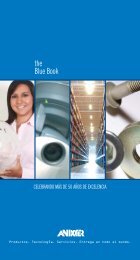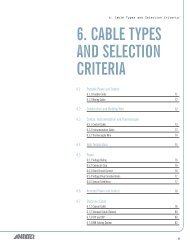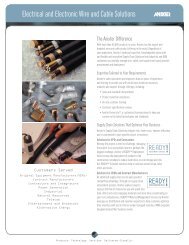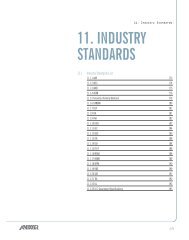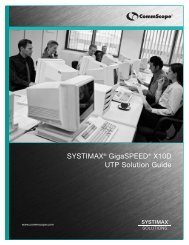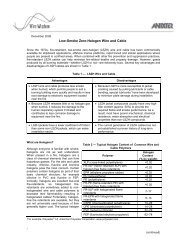An Installation Pocket Reference Guide.pdf - Anixter
An Installation Pocket Reference Guide.pdf - Anixter
An Installation Pocket Reference Guide.pdf - Anixter
Create successful ePaper yourself
Turn your PDF publications into a flip-book with our unique Google optimized e-Paper software.
|5. Fiber Optic Cables<br />
SECTION 5: FIBER OPTIC CABLES<br />
Fiber optic cables consist of a central core that carries light and an outer cladding<br />
that completes the guiding structure. There are two basic fiber types: single-mode<br />
and multimode.<br />
Core Cladding Coating<br />
Figure 5.1 – Fiber Optic Cable<br />
Single-Mode<br />
• Core diameter of 8 to 10 microns<br />
• Normally used for long-distance requirements and<br />
high-bandwidth applications<br />
• Does not bounce light off the surrounding cladding as it travels<br />
Multimode<br />
• Allows more than one mode of light to travel through the cable<br />
• Typical wavelengths of 850 and 1,350 nanometers (nm)<br />
• Normally used in LAN applications<br />
Multimode Fiber Optic Cable Types<br />
Multimode 62.5-micron fiber:<br />
• 62.5-micron core diameter<br />
• 125-micron cladding diameter<br />
Multimode 50-micron fiber:<br />
• 50-micron core diameter<br />
• 125-micron cladding diameter<br />
• Increased bandwidth with smaller size<br />
• Greater bandwidth with laser-optimized 50-micron fiber<br />
62.5-Micron Core<br />
125-Micron Cladding<br />
50-Micron Core<br />
125-Micron Cladding<br />
Figure 5.2 – Fiber Types and Sizes<br />
8-Micron Core<br />
125-Micron Cladding<br />
|48 1.800.ANIXTER




